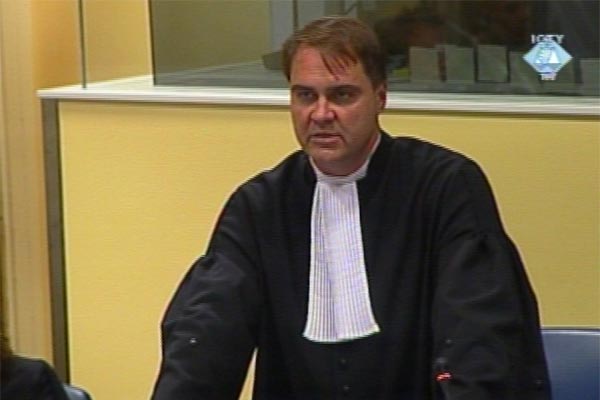Home
PROSECUTION CALLS FOR ADJOURNMENT OF SESELJ TRIAL
‘There is clear evidence that the integrity of the process has been compromised’, the prosecution claims, calling for the adjournment of the Vojislav Seselj trial. The motion has caught the presiding judge by surprise because it has come ‘less than 18 hours before the end of the case’
 Daril Mundis, prosecutor in the Tribunal
Daril Mundis, prosecutor in the Tribunal Claiming that there is ‘clear evidence that the integrity of the process has been compromised’, the prosecution called for an ‘adjournment of the trial’ as the hearing at the trial of the Serbian Radical Party leader Vojislav Seselj drew to a close today . Based on what prosecutor Daryl Mundis was saying, the prosecution decided to do that after the evidence of a witness who was heard in closed session.
Mundis noted that the ‘Trial Chamber is obliged to protect the integrity of the process that has to be fair for both the accused and the prosecution; its duty is to ensure that the witnesses and victims are treated with respect. In his reply to the prosecution motion, the presiding judge Antonetti remarked that the prosecution submitted it ‘less than 18 hours before the end of its case’ because ‘one of its witnesses spoke about threats’. ‘Judges have to verify what the witnesses say’, Antonetti noted adding that ‘the incidents must be investigated’.
Before the hearing went into closed session, Seselj asked a rhetorical question: why would it be in his interest, he said, to intimidate a witness whose evidence he had ‘demolished’?
In the first part of the hearing the judges examined Belgrade pathologist Zoran Stankovic. In April and May 1992 Stankovic conducted postmortems of bodies in Zvornik. He gave a statement about that to the OTP investigators. Seselj is charged with crimes committed by the Serbian Radical Party volunteers from April to July 1992 on several locations in Zvornik: in the Standard shoe factory, Ciglana tile factory, Ekonomija farm and two culture halls, in Drinjaca and in Celopek.
The first post mortem examinations of 29 bodies in April 1992 led Stankovic to conclude that the Muslim victims were mostly killed by infantry weapons. Stankovic found that two men were stabbed to death. Cause of death remained undetermined for one victim. Stankovic came to Zvornik again on 5 May 1995. He then conducted post mortem examinations of 60 or so bodies. He was told that they had been killed in combat.
In his cross-examination, Seselj never mentioned the postmortem examinations Dr. Stankovic described in his evidence. Under the guise of testing ‘the credibility of the witness’, Seselj attempted to get Dr. Stankovic to confirm his arguments that the ICTY is illegitimate, and ‘notorious in the eyes of the Serbian public’, that there is ‘a global anti-Serb conspiracy’, that ‘NATO committed crimes’ and that the judgments of the Tribunal and the International Court of Justice on the Srebrenica genocide are unsafe because they are on shaky foundations. Dr. Stankovic, who served as defense minister in the last government of Serbia and Montenegro for the most part agreed with Seselj.
